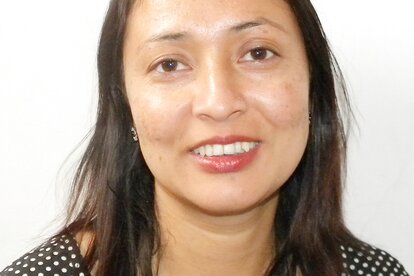Following democratic elections held in 2017, Nepal is now over a year into implementing the process of federalization. This restructuring of the entire political and administrative landscape touches every government service – including agricultural extension. Responsibility for this service has been devolved to the 753 new municipalities in the country. A recent field visit gave many insights into how municipalities can develop their agriculture services in an effective manner, as part of their overall strategic planning and implementation. Here we provide a glimpse from the rural municipality of Marin (Sindhuli district), which is being supported in its agriculture planning through the Nepal Agricultural Service Development Programme (NASDP - Prayas), an SDC project implemented by Helvetas.
Marin rural municipality
Sabita Thapa welcomes us on arrival at the municipality building, and ushers us into the office of the chairman, Paniraj Bamjan, where he and other elected members are already gathered. Sabita is a Junior Agriculture Technical Assistant; aged 22, she has clear ambition and self-confidence. It is she who stands up to explain agricultural progress in the municipality, citing facts and figures from memory whilst all the older men in the room listen. Although many municipalities justifiably complain of a lack of experienced technical staff, young people such as Sabita bring energy and fresh ideas to local government. She speaks of the recently established municipal Agriculture Act, the Economic Development Committee under which lies the Agriculture Development Committee, of the 54 farmers groups that have been registered, the six private farm enterprises, the number and level of subsidies given, and more.
Marin lies in an inner valley of the Sivalik range, mostly 350 - 500m in altitude with a tropical climate suited to the cultivation of paddy, maize and a variety of vegetables such as tomatoes and beans. Until recently, the municipality was poorly accessible, but a new road is being built that will link it to the Terai plains from Chatara to the east, and Sindhuli and thence Hetauda to the west. This will open huge marketing opportunities – opportunities keenly foreseen by the members of the Agricultural Development Committee.
Municipal Agriculture Development Committee
It is the Agriculture Development Committee that is charged with facilitating the development of an agriculture plan for the municipality – considering ward (local level) demands but maintaining strategic coherence. It has nine members, comprising three elected representatives, one government officer and five local persons with varied agricultural expertise. Of course, who sits on the committee determines the degree of impartiality and technical competence - but the coordinator Rajan Thapa (himself an elected ward chairperson), is clear about the committee’s wish to think and consult widely,
“We discuss a lot with other municipalities and amongst ourselves – also with the agriculture college professors [a college has recently been established in Marin]. We are exchanging documents and ideas with our two neighboring municipalities, Sunkosi and Kamalamai. We need ideas, and that has been really useful with the Prayas support – being able to test ideas, such as giving training on the different types of pesticide available for vegetables and their proper use…..We in the committee are not necessarily the most knowledgeable, we need to learn from farmers who have knowledge and experience.”
Knowledgeable farmers as Local Resource Persons
One farmer who certainly has knowledge and experience is Tara Bahadur Bharel, who worked for eight years in Malaysia before returning home some two years ago. He has benefitted from a municipal program devised with Prayas support that recognizes returnee migrants as potential entrepreneurs and Local Resource Persons who can train others. He received nursery training and underwent a 16-week training on Integrated Pest Management (IPM). In addition, he benefitted from plastic sheeting for his polytunnels, bought in bulk by the municipality and distributed at a 50% subsidy. With some of the money he made in Malaysia, he has bought a plot of land in a nearby village and is now persuading all the farmers in that vicinity to grow vegetables.
Tara Bahadur Bharel, Sindhuli
One can wonder about the equity aspects of supporting a limited number of individuals with hefty subsidies – but this approach is deeply ingrained in government thinking and citizen expectations. Municipal Chair Mr Bamjan is aware of potential criticism, and specifically noted the need for data collection on the socio-economic status of people within the municipality to inform an appropriate pro-poor subsidy policy.
As a subsidy recipient, Tara Bahadur points out that the support he’s received has led to the employment of six women part time this year and last. We quickly calculate that at the local daily wage rate of NRs 400, he only needs to have offered 25 days of work to each of these women to have covered the cost of the subsidy. In such a case, perhaps the municipality’s investment is worthwhile; nevertheless, there is scope for reflection.




